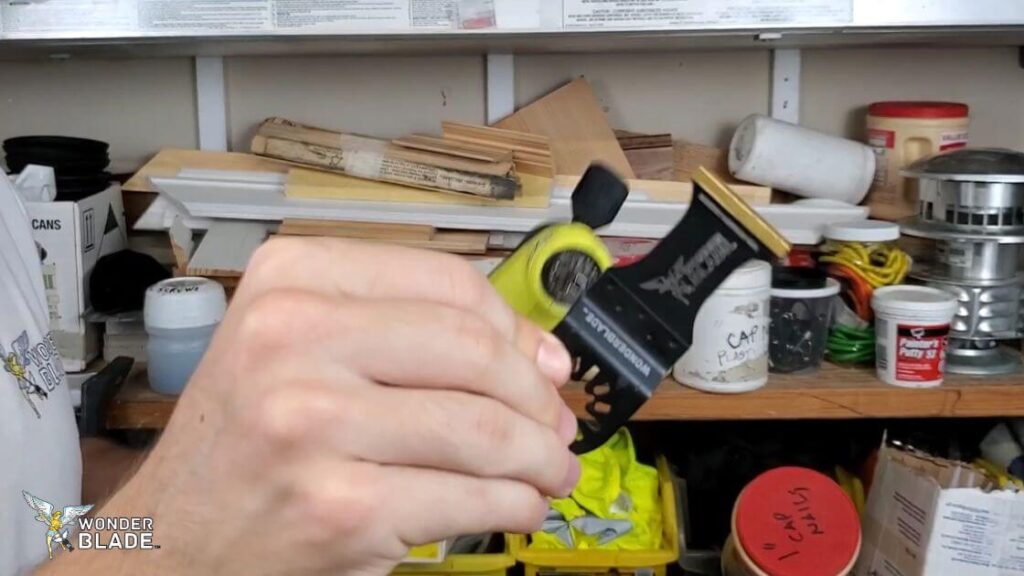
Oscillating tools are versatile power tools that can be used for a variety of tasks. They are designed to vibrate rapidly back and forth in a small range of motion, allowing users to cut and sand through various materials with precision.
Whether you’re cutting, scraping, grinding, or sanding, an oscillating tool is the perfect tool for the job. In this article we will cover what an oscillating tool is, how it works, and how to attach a blade to your oscillating tool.
Choosing the right blade for your oscillating tool is essential to ensure that you get the best performance out of your tool. With a universal fitting, you can attach blades to a wide variety of oscillating tools. This makes it easier to find the right blade for your specific needs.
When selecting a blade, consider its size, shape, and material. The size should be appropriate for the job at hand and the shape should be suitable for cutting through different materials.
Additionally, make sure that the material is strong enough to withstand wear and tear over time. Finally, make sure that it has a universal fitting so that it can be attached to any oscillating tool.
Attaching a blade to an oscillating tool is a relatively simple process that can be done in just a few steps. It is important to make sure that the blade is securely attached and properly aligned before using the tool.
This guide will provide step-by-step instructions on how to attach a blade to an oscillating tool, including what tools are needed and safety precautions. With these instructions, you can easily attach your blade and get started with your project.
Oscillating multi-tools are a great option if you’re looking for an all around tool for multiple uses. You can use these an oscillating tool to cut, scrape, and sand.
What’s more, changing the attachments is quite simple, newer type oscillating tools from Ryobi and Milwaukee for example do not require an Allen wrench since they have a self locking mechanism, however there are other oscillating tools that may need an Allen wrench for attaching and taking off the oscillating tool blade.
Simply take the Allen wrench and use it to remove the bolt at the bottom of the attachment or head. Sometimes an adapter will already be on so if it falls off when you remove the bolt make sure you save it.
If you are using attachments from a different manufacturer you’ll have to use an adapter. Line up your adapter over the current attachment holder and then place the attachment you’d like to use onto the new adapter and then bolt both pieces into place.
Oscillating tools are quite efficient and can be used with a variety of accessories to achieve the desired results. It is important to select the most suitable blade or accessory for your project, as this will allow you to complete your job or project faster while avoiding excessive wear and tear on the blades.
Before getting started, make sure to pick the right oscillating tool blade for the job. Most blades and attachments have labels that let you know what they are used for cutting.
For a straight cut, using a round or half-moon oscillating blade is the most efficient method. You should press down on your tool lightly enough to only make a maximum depth of 1/4 inch for each cut. Then repeat this process multiple times, gradually increasing the depth until you have cut through your material.
Avoid applying too much pressure on the oscillating tool while cutting through materials like you would with a jigsaw or reciprocating saw blade. Doing so can lead to overheating and faster wear & tear of your cutting blades.
It is important to take the necessary steps to ensure that the blade is securely attached and that it will not come loose during use. This includes making sure that the blade is properly aligned, using the correct size of screws, and ensuring that all screws are tightened securely.
Additionally, it is important to wear protective gear such as gloves and safety glasses when attaching a blade to an oscillating tool. Taking these safety precautions can help prevent serious injury or damage while using an oscillating tool with a blade attached.
Oscillating tools are a versatile and powerful tool used for cutting, sanding, grinding, and scraping. They are available in various brands such as DeWalt, Milwaukee, Rigid, etc. Each brand offers different features and benefits that make them suitable for different types of projects.
When choosing an oscillating tool, it is important to consider the type of project you will be working on and the features offered by each brand.
Milwaukee oscillating tools are known for their durability and power while Rigid & Ryobi oscillating tools offer a more affordable option with good performance.
It’s equality important to have an good all around oscillating tool blade that lasts dozens of cuts and lasts 100x longer than any other typical oscillating blade in the industry. Check it out here.
In short, learning how to attach blade to oscillating tool shouldn’t be difficult when you have the right adapter and related parts. Older model oscillating tools do not have an automatic locking mechanism and may need an Allen wrench along with the related adapter for the oscillating blade to be placed in correctly.
Submit your questions, thoughts, or concerns to help us make better content just for you: